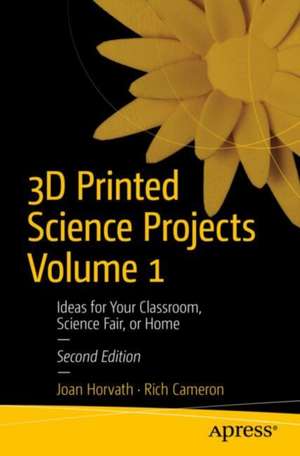3D Printed Science Projects Volume 1: Ideas for your classroom, science fair or home
Autor Joan Horvath, Rich Cameronen Limba Engleză Paperback – 28 dec 2024
Create 3D printable models that can help students from kindergarten through grad school learn math, physics, botany, chemistry, engineering and more.
Each of the eight topics is designed to be customized by you to create a wide range of projects suitable for science fairs, extra credit, or classroom demonstrations. Science fair project suggestions and extensive "where to learn more" resources are included, too. You will add another dimension to your textbook understanding of science.
For this New Edition:
The second edition of 3D Printed Science Projects is a thorough update of the original, modernizing the 3D printing technology. 3D Printed Science Projects shows you how to create 3D printable models that can help students from kindergarten through grad school learn math, physics, botany, chemistry, engineering and more. Each of the models is created in the free, open source CAD program OpenSCAD, so it can be customized by the reader. This allows the models to be the basis of open-ended STEM projects at a variety of levels.
The second edition of 3D Printed Science Projects is a thorough update of the original, modernizing the 3D printing technology. 3D Printed Science Projects shows you how to create 3D printable models that can help students from kindergarten through grad school learn math, physics, botany, chemistry, engineering and more. Each of the models is created in the free, open source CAD program OpenSCAD, so it can be customized by the reader. This allows the models to be the basis of open-ended STEM projects at a variety of levels.
What You'll Learn
- Create (and present the science behind) 3D printed models.
- Use a 3D printer to create those models as simply as possible.
- Discover new science insights from designing 3D models.
Who This Book Is For
3D Printed Science Projects particularly targets the technology-squeamish teacher or parent who want their kids tolearn something from their 3D printer but need help getting started. Kids who love science, homeschoolers (and the grandmas who buy them birthday presents) will be customers.
Preț: 261.64 lei
Preț vechi: 327.04 lei
-20% Nou
Puncte Express: 392
Preț estimativ în valută:
50.08€ • 54.42$ • 42.09£
50.08€ • 54.42$ • 42.09£
Carte disponibilă
Livrare economică 31 martie-14 aprilie
Preluare comenzi: 021 569.72.76
Specificații
ISBN-13: 9798868803413
Pagini: 250
Ilustrații: Approx. 250 p.
Dimensiuni: 155 x 235 mm
Greutate: 0.51 kg
Ediția:2nd ed.
Editura: Apress
Colecția Apress
Locul publicării:Berkeley, CA, United States
Pagini: 250
Ilustrații: Approx. 250 p.
Dimensiuni: 155 x 235 mm
Greutate: 0.51 kg
Ediția:2nd ed.
Editura: Apress
Colecția Apress
Locul publicării:Berkeley, CA, United States
Cuprins
Chapter 1: Math Modeling with 3D Prints.- Chapter 2: Light and Other Waves.- Chapter 3: Gravity.- Chapter 4: Airfoils.- Chapter 5: Simple Machines.- Chapter 6: Plants and Their Ecosystems.- Chapter 7: Molecules.- Chapter 8: Trusses.- Chapter 9: Gears.- Appendix A: Links.
Notă biografică
As an engineer and management consultant, Joan Horvath has coordinated first-of-a-kind interdisciplinary technical and business projects, helping people with no common vocabulary (startups, universities, small towns, etc). work together. Her experience as a systems engineer has spanned software development, spacecraft flight operations, risk management, and spacecraft/ground system test and contingency planning.As an educator, Joan’s passion is bringing science and technology to the non-specialist in a comprehensible and entertaining way that will stay with the learner for a lifetime.
Rich Cameron is a co-founder of Pasadena-based Nonscriptum LLC. Nonscriptum consults for educational and scientific users in the areas of 3D printing and maker technologies. Rich (known online as “Whosawhatsis”) is an experienced open source developer who has been a key member of the RepRap 3D-printer development community for many years. His designs include the original spring/lever extruder mechanism used on many 3D printers, the RepRap Wallace, and the Deezmaker Bukito portable 3D printer. By building and modifying several of the early open source 3D printers to wrestle unprecedented performance out of them, he has become an expert at maximizing the print quality of filament-based printers. When he's not busy making every aspect of his own 3D printers better, from slicing software to firmware and hardware, he likes to share that knowledge and experience online so that he can help make everyone else’s printers better too.
Caracteristici
Book covers 8 separate, customizable projects, each applied to a different topic Learn to use a 3D printer to create these and other models as simply as possible Science fair project suggestions and extensive "where to learn more" resources are included
